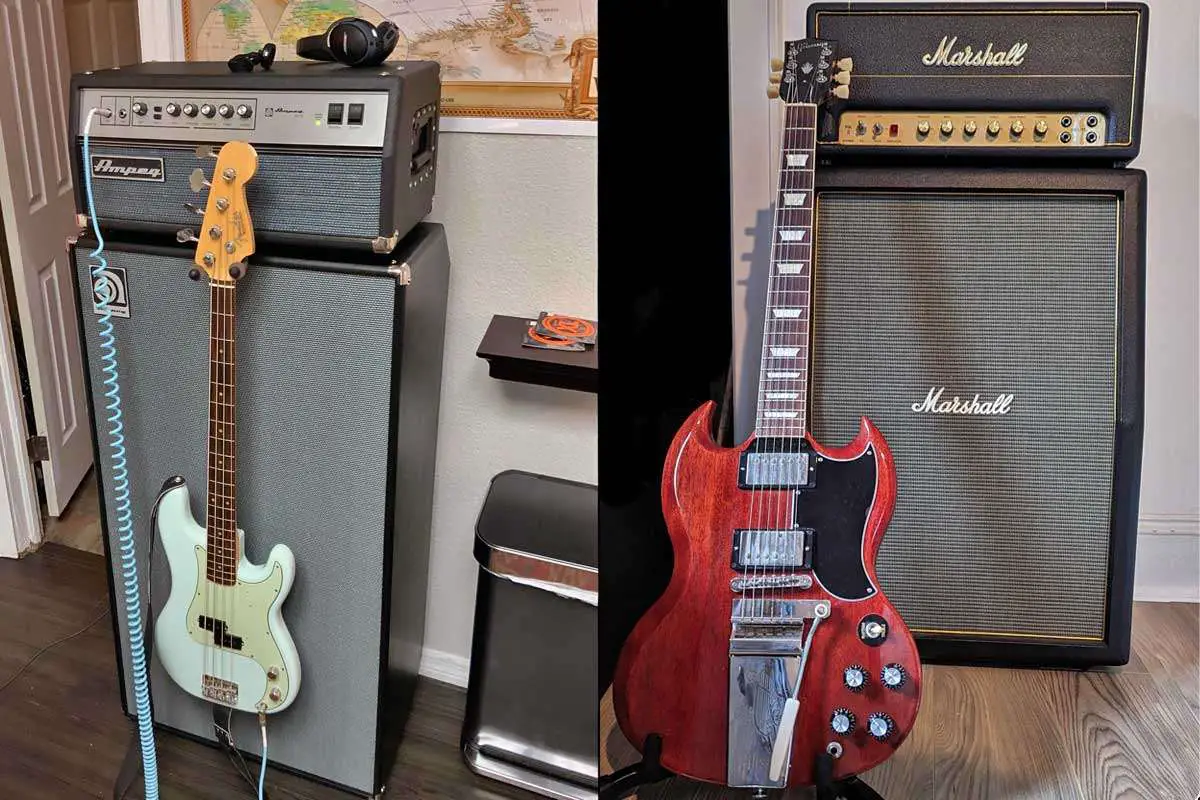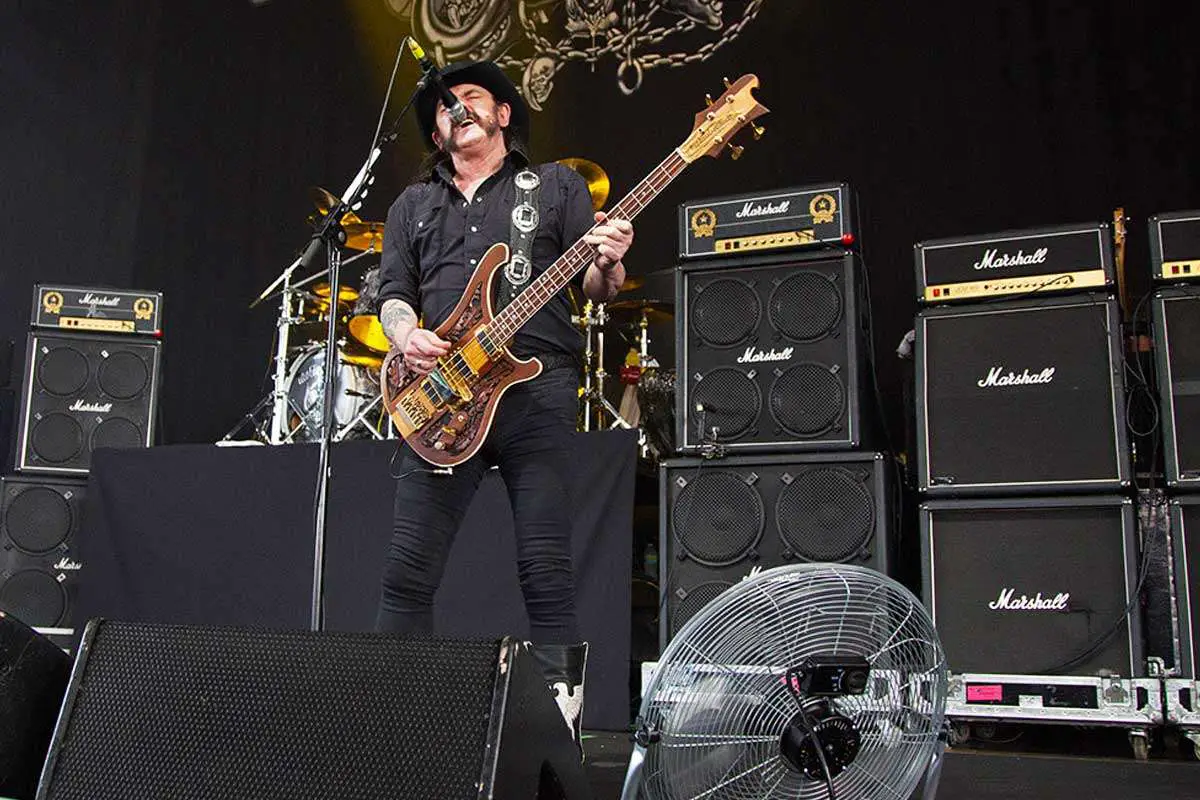Understanding the differences between bass amps vs guitar amps is critical for any musician aiming to optimize their instrument’s sound. Bass amps and guitar amps are engineered with distinct tonal goals in mind. Your bass amp is designed to handle low-frequency sounds and to reproduce the deep, powerful bass notes you play. This involves not just more robust construction to handle the lower frequencies, but also circuitry tailored for a bass guitar’s sonic needs.
Guitar amps, on the other hand, are crafted to produce a wide range of frequencies that are well-suited to the midrange tones of a guitar. The preamp and gain stages in these amps, often involving tubes like the 12AX7, are essential for shaping the intricate harmonic content a guitar generates.
Mixing bass amps and guitar amps is generally not recommended. Bass amps are designed to handle the lower frequencies of a bass guitar, while guitar amps are optimized for the higher frequencies of a regular guitar. Using the wrong amp can lead to distortion, damage to the equipment, and an undesirable sound. Stick to the appropriate amp for your instrument to ensure optimal performance and sound quality.

Fundamentals of Guitar and Bass Amps
When you explore guitar and bass amplifiers, you’ll discover that their design, power, and speakers reflect the distinct sonic signatures these instruments carry. Your understanding of these components can help you select the right amp for your music-making needs.
Design Principles
Guitar amps and bass amps are built around different design principles. A guitar amp is typically designed to enhance higher frequencies and often incorporates circuitry that adds distortion, which can enrich the guitar’s tone. On the other hand, bass amps prioritize clean power and clarity for low-end frequencies. They often feature robust circuit board designs and beefier transformers to handle the significant power required to reproduce bass frequencies without distortion.
Speaker cabinets and amp heads for both instruments might include an array of controls and channels for shaping the sound, with options for adding gain and adjusting the master volume control. Modeling amps replicate a variety of sounds by emulating different amplifiers’ circuitry electronically.
Power and Wattage
The power and wattage ratings of your amplifier are crucial. For guitarists, amps can range from low-power models (around 5 to 30 watts) for practice and small venues, to powerful stacks for large venues or when you need unyielding volume. Bass players will typically require more power to ensure their sound is heard clearly. This means bass amps generally start at higher wattages, with many models offering 100 watts or more to produce the necessary volume without losing tone quality.
A higher wattage also means achieving a great sound at lower volumes due to the equipment’s improved headroom. In practice, this allows you to maintain a clean tone even as you increase the volume.
Speaker Characteristics
Speaker size plays a pivotal role in how an amplifier produces sound. Guitar amp speakers are often smaller in diameter (commonly 10 to 12 inches), which helps produce a focused and nuanced mid-range suited for guitars. Bass amp speakers are usually larger (starting at 15 inches) to handle the lower frequencies and provide the necessary punch and depth.
Along with size, the construction of the speaker cabinet also impacts the sound. A closed-back cabinet will generally offer a more directed and punchier output, while open-back designs may present a wider, more airy sound.
Furthermore, bass amps may integrate tweeters or smaller speakers to handle the demands of higher-frequency content, ensuring that the full range of the bass is delivered accurately.
Related: Can Guitar Cables Be Used For Bass
Sound Production and Frequency Response
When you explore the world of amplifiers, understanding the intricacies of sound production and frequency response within bass and guitar amps is critical. These components are what give each instrument its unique voice and performance characteristics.
Tonal Differences
The tone of your amplifier is shaped by its voicing. Bass amps are designed with low frequencies in mind, emphasizing the weight and vibration of bass signals. Electric guitar amplifiers, on the other hand, accentuate a broader frequency range to capture both the warm low-end and sparkling high frequencies. This difference in voicing is crucial as it ensures that the sound produced matches the sonic character of the instrument.
Frequency Range and EQ
- Bass Guitar: Typically, the frequency range of a bass guitar extends from about 41Hz to 350Hz. Modern bass players often utilize EQ settings to amplify low notes while maintaining clarity. The EQ on bass amps typically features controls that can shape sounds below 100Hz, which are essential for performance impact.
- Electric Guitar: The electric guitar spans a much wider frequency range, usually from around 82Hz to 5kHz. The EQ plays with shorter wavelengths, allowing for more precise adjustments that affect texture and articulation. High frequencies can be managed to on guitar amps to ensure signal purity and to avoid harshness.
By understanding the frequency response of your gear and adjusting your EQ settings accordingly, you unlock the potential for richer, more resonant performances whether through a bass or guitar amp.
Related: A Guide To Amp Settings
Popular Amp Models and Their Features
Selecting the right amplifier is crucial to achieving the sound you desire. Whether striving for the rich warmth of vintage models or the versatility of modern technology, your choice will shape your musical expression.

Iconic Amps History
Fender Bassman: Initially designed for electric bass guitars, the Fender Bassman has been embraced by guitarists for its robust low-end and pristine treble. You’ll find the Bassman’s signature sound in genres ranging from blues to rock, owing to its four 10-inch bass cabinets and the natural overdrive it imparts at high volumes.
Marshall Amplifiers: Jim Marshall, known as “The Father of Loud,” developed some of the most iconic big guitar amplifiers. Marshall’s classic amps, like the distorted Marshall used in nu-metal and for down-tuning, offer the unmistakable growl and amazing sounds that have defined rock. Famous bassists like Lemmy from Motörhead often used modified versions to pair with his Rickenbacker bass, influencing the heavy rock sound many chase after.
Modern Innovations
Modern Combo Bass Amps: These amps merge the traditional amp head and bass cabinets into a single unit, often equipped with features like digital modeling and effects loops. They can emulate the tone of classic amps while providing advanced controls for distortion, reverb, and chorus.
Related: Types of Guitar Pedals & Their FX
High-Wattage Requirement & Electric Bass Guitar: As you delve into genres that demand more power and presence, like hard rock or metal, you’ll notice that wattage becomes a pivotal factor. Players often choose amps with higher wattage to ensure that the deep tones of an electric bass guitar cut through mix, especially when active pickups are employed.
Your research into amps should also consider combo bass amps for convenience versus a separate head and cabinet for flexibility. Whether you go for passive or active models can influence your rig setup, as active basses tend to have more onboard controls and enhancements.
Remember, your journey through understanding amplifiers will also require personal experimentation to achieve the sound that’s right for you.
